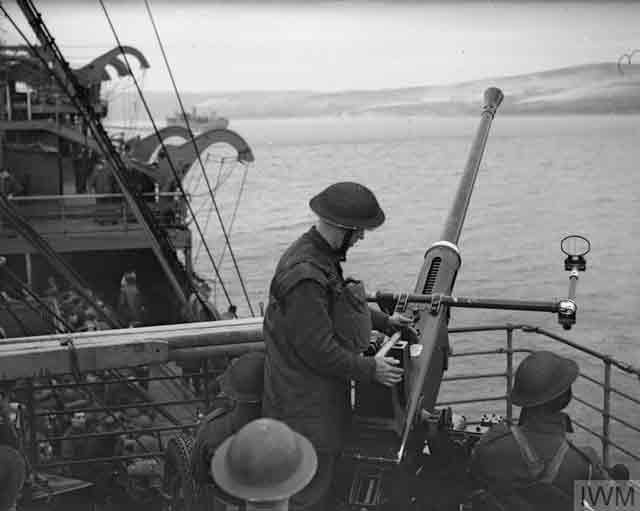Monday 5 January 1942
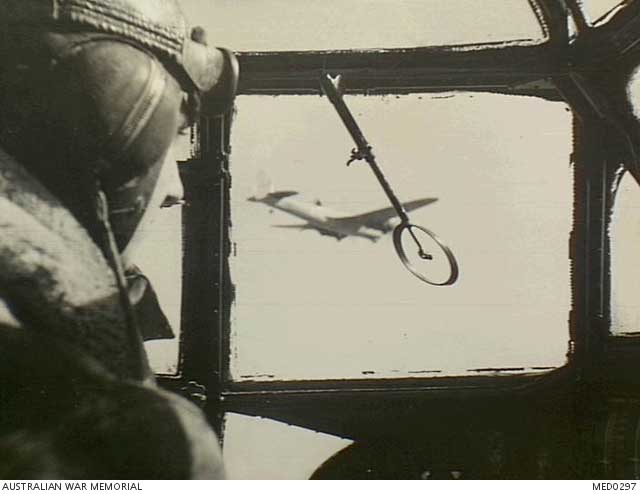 |
| "Western Desert, Egypt. 5 January 1942. En route to a raid on Halfaya, this pilot of a Bristol Blenheim bomber aircraft looks through his gunsight as the raiding aircraft sweep down on the isolated Axis positions. Ceaseless attacks are being carried out by RAF and Free French squadrons." Australian War Memorial MED0297. |
Eastern Front: The Soviet leaders have been greatly surprised by the success of the counterattack around Moscow that began in early December 1941. On
5 January 1942, the political and military leaders make plans to convert the counteroffensive into a general offensive that will liberate vast sections of Soviet territory. After dark, the Politburo (political) members meet with Stavka (military) members to discuss a drive not only to relieve pressure on Moscow, but also to liberate Leningrad, the Donets Basin, and the Crimea. While the offensives in the Crimea and around Moscow already are in progress, the ones near Leningrad and in the Donets Basin are scheduled to begin on 7 January 1942 for the former and in two weeks for the latter.
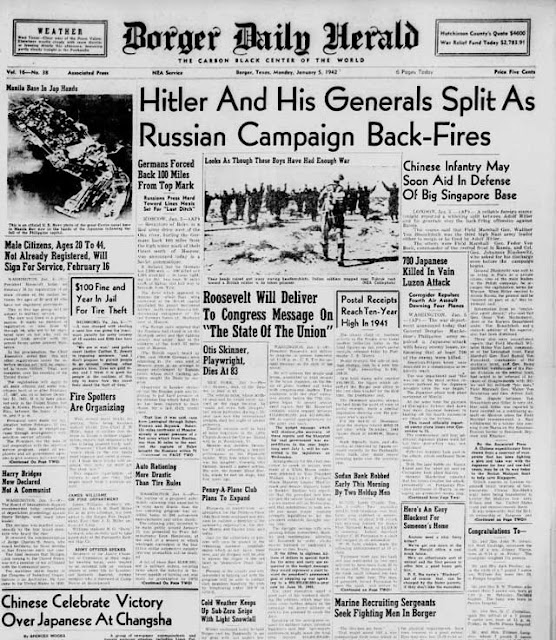 |
| Borger Daily Herald (Borger, Tex.), Vol. 16, No. 38, Ed. 1 Monday, January 5, 1942. The Daily Herald headline correctly reads, "Hitler and His Generals Split as Russian Campaign Back-Fires." |
Stalin presides over the meeting, as usual, and notes the reason for expanding the offensive:
The Germans are in confusion as a result of their setback at Moscow. They are badly prepared for winter. Now is the best moment to over to the general offensive.
Stalin then asks General Georgy Zhukov to speak, apparently without coordinating what Zhukov should say beforehand. Surprisingly, Zhukov disagrees with Stalin, which is extremely unusual, particularly in such an open setting. Zhukov contends that the entire effort should be made in the center of the front around Moscow and not dispersed to other areas. Another official present, member of the State Defense Committee and chief of war production Nikolai Voznesensky, then is asked to speak and basically supports Zhukov, not Stalin. Voznesensky notes that there would not be enough ammunition and weapons to sustain offensives in different places, so only one area should be chosen. It is an extraordinary display of independence among people in very vulnerable positions.
 |
| Images from a 5 January 1942 Life magazine article on life in the US Navy after Pearl Harbor. |
However, Stalin is not upset, but he does have the last word. He concludes by saying:
We must pound the Germans to pieces as soon as possible so they won't be able to mount an offensive in the spring.
Stalin's plan for a general offensive in multiple places is adopted. Some members present at the meeting are surprised that Zhukov took a different position than Stalin. Martial Boris Shaposhnikov pulls Zhukov aside and chastises him for disagreeing because "the supreme commander had that question settled." Zhukov notes that he spoke his mind because his opinion had been requested, and asks why was he asked to speak it if it only supposed to be the same as Stalin's? This stumps Shaposhnikov, who lamely replies, "That, my dear fellow, I do not know."
 |
| Images from a 5 January 1942 Life magazine article on life in the US Navy after Pearl Harbor. |
The Soviet counteroffensive already is making progress both in the Crimea and around Moscow. Soviet 51st Army finally reaches the Parpach Narrows today after a slow move west from Kerch, but it takes no offensive action. Further north, the Soviet 10th Army takes Belov (Belyov or Belev) south of Kaluga and southwest of Tula. The front is gradually drifting away from Moscow and freeing up large areas where the Soviets can begin rebuilding.
 |
| "A view of MASB 37 as seen from the bow. The Commanding Officer is seen directing the operation from his tiny bridge while the machine gunner is at the ready." MASB 37 in the Firth of Forth, 5 January 1942. © IWM (A 6958). |
Battle of the Pacific: The United States military on 5 January 1942 is beginning to recover its equilibrium after the shock of the Japanese attack on Pearl Harbor. Today, the air echelon of the 22d Bombardment Squadron, 7th BG (Heavy), leaves Hickam Field, Hawaii, in its B-17s and heads for Singosari, Java.
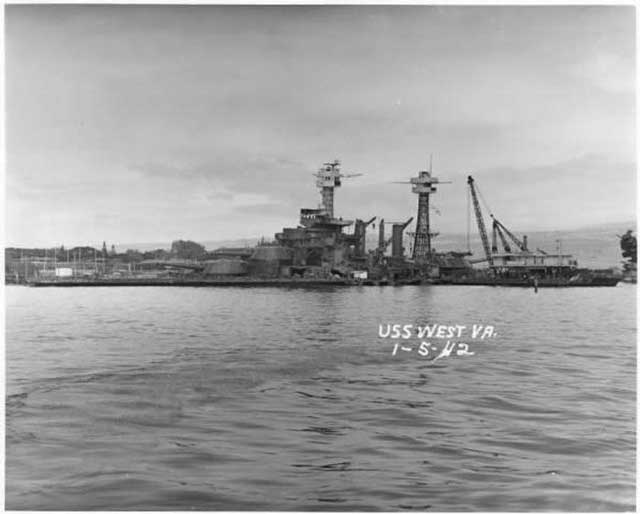 |
| This photo of USS West Virginia (BB-48) taken on 5 January 1942 shows bomb and fire damage from the attack on Pearl Harbor on 7 December 1941. |
Food is running low and resupply appears problematic in the Philippines, so rations for everyone are cut in half. The Allies form a new line running from Dinaluplhan on the west to Hermosa on the east. This protects the entrance to, or base of, the Bataan Peninsula from the north and east and is the center of communications in the northern portion of the peninsula. The withdrawal continues after dark, with the troops passing through Layac Junction and then blowing the bridge there. They continue to hold the junction itself until the 6th. The 71st and 72d Regiments, 71st Division, Philippine Army, the U.S. 31st Infantry Regiment of the Philippine Division, and the 26th Cavalry Regiment, Philippine Scouts form a switch line south of Layac along the west side of the Olongapo-Manila road.
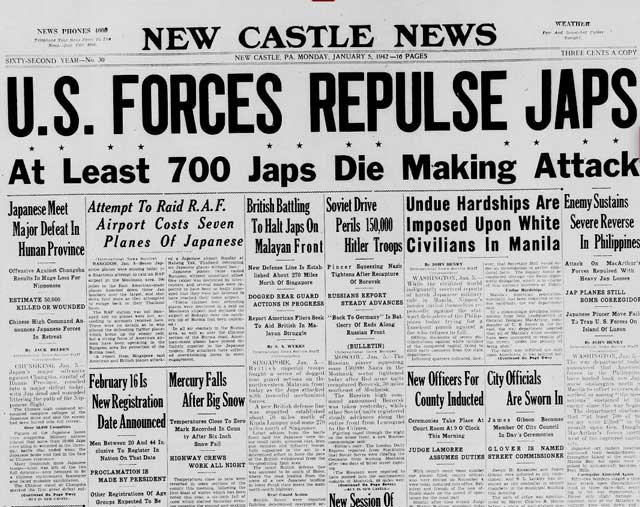 |
| With the war in the Philippines going poorly for the Allies, the US media reverts to its practices from just after Pearl Harbor and prints accounts of nonexistent victories there. Here, the New Castle (Pennsylvania) News of 5 January 1942 gives stirring tales of fabulous American victories in the Philippines while the US forces, in fact, are retreating under pressure into the Bataan Peninsula. |
The US Army Air Forces continue a hurried reorganization of their deployments in the Philippines. Brigadier General Richard J. Marshall establishes the Headquarters US Army Forces Far East (USAFFE) in Bataan. The ground echelons of the 17th and 91st Bombardment Squadrons, 27th Bombardment Group transfer from Limay to Bataan. The Japanese are attacking Corregidor every day and also select targets in the Manila Bay area.
 |
| Images from a 5 January 1942 Life magazine article on life in the US Navy after Pearl Harbor. |
The British are building up their presence in Burma as the Japanese consolidate their hold on the southernmost sliver of land running south to the west of Thailand. The Indian 17th Division moves into new headquarters at Moulmein at the top of the sliver of land to form a block against a Japanese advance into the heart of the country. However, only one of three brigades that constitute the division, the 16th Brigade, while two remain behind in India.
 |
| Images from a 5 January 1942 Life magazine article on life in the US Navy after Pearl Harbor. |
At Singapore, the British begin planning for the worst. The Commander-in-Chief British Eastern Fleet, Admiral Sir Geoffrey Layton, moves his flag (headquarters) from Singapore to Batavia, Java, Netherlands East Indies. At a conference in Segamat, Lieutenant General Arthur Percival, General Officer Commanding Malaya Command, plans for a retreat into Johore.
 |
| This situation map of the battle at Layac Junction is based on materials that came from the United States Army Center of Military History. |
Further north on the Malay Peninsula, the Indian 11th Division continues to hold its main defensive line anchored at Trolak just north of the Slim River. However, it is today it comes under pressure. The British have chosen to defend a narrow roadway between heavily forested areas that are just north of the Cluny Rubber estate, where the forests have been cut down and which is just north of the Slim River. During the afternoon, the Indian 5/16th Brigade on the coast pulls back through the 12th Indian Brigade positions, which is positioned on the north bank of the Slim River. The advance guard of the Japanese 42nd Regiment following close behind then launches an attack on the 12th Indian Brigade that leaves 60 Japanese soldiers dead on the battlefield. The leader of the Japanese Regiment, Colonel Ando, then decides to await reinforcements before launching further attacks. While the Allies' line holds, the situation looks grim for them because the Japanese can bring up more troops and the Allies don't have a lot of troops to spare. In addition, and unknown to the British, the Japanese have a large number of tanks quickly heading south, while the Allies have none available at all.
 |
| Life magazine prints this picture of an unidentified US Navy cruiser in its 5 January 1942 issue. |
Battle of the Mediterranean: In a rare victory by one submarine over another, British submarine HMS/M 'Upholder' (N 99, Lieutenant-Commander Malcolm David Wanklyn) torpedoes and sinks 1461-ton Italian submarine Ammiraglio Saint Bon to the north of Milazzo, Sicily. There are three survivors and 59 deaths. The Ammiraglio Saint Bon was en route from Naples to Tripoli carrying 155 tons of gasoline and ammunition, which explode when the torpedo hits the starboard side. This is a demoralizing blow to the Axis because it demonstrates that not even submarine transport is safe in the Mediterranean.
 |
| "Benghazi, Cyrenaica, Libya. 5 January 1942. The scene at El Berca airfield showing the wreckage of the many Axis aircraft destroyed and a densely filled cemetery behind." Australian War Memorial MED0274. |
Battle of the Mediterranean: Following the large Luftwaffe raid on Malta on 4 January, the British intelligence service in Cairo learns that the Germans have assembled powerful dive-bomber forces in Sicily for further attacks. There also are reports from an aerial reconnaissance of an Italian battleship accompanied by other ships about 200 miles to the east. The Germans conduct several raids around mid-day which drop bombs over Gozo, Msida Creek, near Tal Qroqq, near Gudja searchlight position, and in Zabbar. The British defenses are hampered by heavy rains recently, which have made the grass airfields waterlogged and sometimes impossible to use. The RAF manages no interceptions during the day, and the Luftwaffe loses no planes nor has any damaged, a rarity for days with sustained attacks.
 |
| Time magazine, 5 January 1942 (cover photo credit: Ernest Hamlin Baker). |
Western Front: RAF Bomber Command sends 89 Wellington bombers and 65 other aircraft (154 total) to attack the port area of Cherbourg and other German naval bases. The Kriegsmarine still has heavy cruisers Prinz Eugen, Scharnhorst, and Gneisenau at Cherbourg. The Germans make smoke, which successfully destroys the bombers' aim. While the warships are not hit, there is damage to the port area and large fires. The German admirals begin thinking of a way to get the large ships out of harm's way, but options are limited. One thing is sure, the Germans don't have much time to act before the raids begin causing serious damage.
 |
| Images from a 5 January 1942 Life magazine article on life in the US Navy after Pearl Harbor. |
US/Japanese Relations: While Japan and the United States are at war, there are still certain diplomatic formalities to discharge. Each side is obligated to return the other's diplomats, for instance. The Japanese accept the port of Laurenzo Marques (Maputo) in Mozambique for this exchange of diplomats.
 |
| On 5 January 1942, Rear Admiral Ben Moreell, Chief of the Navy’s Bureau of Yards and Docks, is given authority from the Bureau of Navigation to recruit men from the construction trades for assignment to a Naval Construction Regiment composed of three Naval Construction Battalions. The first construction units, later nicknamed Seabees for the acronym of "Construction Battalions," are formed at a newly constructed naval bast at Davisville, Rhode Island. (Postcard from the U.S. Naval Construction Training Center, Camp Endicott, Davisville, Rhode Island. Gift of Gay Meaker, The National WWII Museum Inc., 2003.103.095). |
US Military: US Forces in Australia (USFIA), which controls Far East Air Force (FEAF), is activated and redesignated US Army Forces in Australia (USAFIA). It is under the overall command of Major General George H. Brett, and its headquarters is located in the MacRobertson Girls High School in Melbourne, Victoria.
All men aged 20-44 now are required to register for the draft no later than 16 February 1942. All Japanese-American selective service registrants are classified as enemy aliens (IV-C). Many Japanese-American soldiers are discharged or assigned to menial labor such as kitchen police (KP) duty.
 |
| "A squadron of Japanese raiders speck the sky above the smoke clouds rising from the dirty work they wrought below." Images from a 5 January 1942 Life magazine article on life in the US Navy after Pearl Harbor. |
The US Navy changes its regulations covering the display of national insignia on aircraft. The star returns to the upper right and the lower left wing surfaces, and there is a revised rudder striping that now has 13 red and white horizontal stripes.
 |
| "A repair and salvage party at work on a motor cutter which broke down and went ashore in a gale." Scapa Flow, 5 January 1942. © IWM (A 6951). |
Australian Military: The War Cabinet in Canberra approves a British request for transfer of the Australian I Corps (6th and 7th Divisions) from the Middle East to Southeast Asia. The British also begin moving the British 18th and Indian 17th Divisions from the Middle East to Bombay, India; Ceylon; and Singapore, Malaya. These British initiatives are designed to allay Australian and New Zealand fears that the British will focus exclusively on the Middle East battles while allowing the Far East territories to remain in peril.
British Military: British General Claude E. Auchinleck, Commander in Chief Middle East Command, has his authority expanded to include Iraq and Iran. British forces in Iraq are designated British Tenth Army under Lieutenant General Edward P. Quinan, with Ninth Army covering British forces in Syria under General Sir Henry Maitland Wilson.
 |
| Images in the 5 January 1942 issue of Life magazine showing life aboard a US Navy cruiser. |
Holocaust: The Dutch Council of Churches issues a public protest against the mistreatment of Jewish residents. All Dutch Jews already are required to register with occupation authorities, but mass exterminations have not begun.
American Homefront: All enemy aliens in San Francisco, California, are required to surrender by the end of the day all radio transmitters, shortwave receivers and precision cameras to the U.S. Army's Western Defense Command under Lieutenant General John DeWitt.
 |
| The cover story for the 5 January 1942 Life magazine is "Wanted: 50,000 Nurses." |
1942January 1942January 1, 1942: Declaration By United NationsJanuary 2, 1941: Manila Falls to JapanJanuary 3, 1942: ABDA Command AnnouncedJanuary 4, 1942: MacArthur on His Own in the PhilippinesJanuary 5, 1942: Soviets Plan General OffensiveJanuary 6, 1942: US Army in EuropeJanuary 7, 1942: Soviet General Offensive OpensJanuary 8, 1942: Hitler Sacks HoepnerJanuary 9, 1942: Battle of DražgošeJanuary 10, 1942: Building the JeepJanuary 11, 1942: Japan Takes Kuala LumpurJanuary 12, 1941: Rommel Plans CounterattackJanuary 13, 1942: First Ejection Seat UseJanuary 14, 1942: Operation Drumbeat First SinkingJanuary 15, 1942: U-Boat Off NYCJanuary 16, 1942: Carole Lombard CrashJanuary 17, 1942: British Take Halfaya PassJanuary 18, 1942: Soviet Paratroopers in ActionJanuary 19, 1942: FDR Approves Atomic BombJanuary 20, 1942: The Wannsee ConferenceJanuary 21, 1942: Parit Sulong Bridge BattleJanuary 22, 1942: Parit Sulong MassacreJanuary 23, 1942: Japan Takes RabaulJanuary 24, 1942: Battle of Makassar StraitJanuary 25, 1942: Kholm SurroundedJanuary 26, 1942: GIs Land in EuropeJanuary 27, 1942: Battle of EndauJanuary 28, 1942: Rommel Takes BenghaziJanuary 29, 1942: First US Coast Guard Ship SunkJanuary 30, 1942: Singapore IsolatedJanuary 31, 1942: Army Group South Averts Disaster2020



























